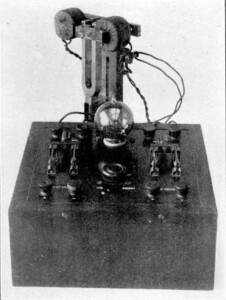 This site often features science fair projects, and we often specialize in impressive projects that can be whipped together in one evening. This project doesn’t come in that category, but the advanced student who is willing to do some tinkering can replicate this tuning fork oscillator from the October 1941 issue of General Radio Experimenter.
This site often features science fair projects, and we often specialize in impressive projects that can be whipped together in one evening. This project doesn’t come in that category, but the advanced student who is willing to do some tinkering can replicate this tuning fork oscillator from the October 1941 issue of General Radio Experimenter.
Shown above is a tuning-fork oscillator utilizing a vacuum tube and a tuning fork. It is used to produce a very precise audio tone using an electro-mechanical process. The vacuum tube serves as the oscillator (and a modern recreation could just as easily use a transistor), and a mechanical tuning fork serves to determine the frequency. A simplified schematic diagram is shown below. The tuning fork needs to be ferrous in order for it to work.

WWV 1927 frequency standard. Wikipedia image.
A similar circuit was used for the frequency standard for WWV in 1927, as shown at the left. Advanced students wishing to duplicate this project will find some guidance at this site and this site. Students looking for the more familiar last-minute but impressive projects can browse our science fair category for ideas.

